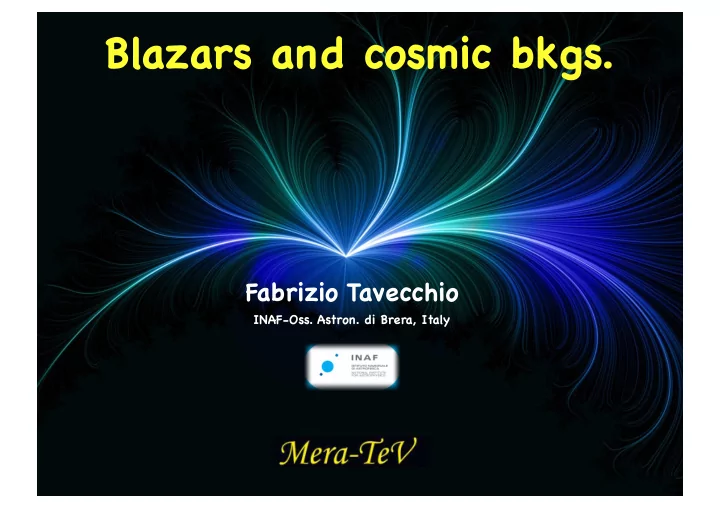

Blazars and cosmic bkgs. Fabrizio Tavecchio INAF-Oss. Astron. di Brera, Italy
Introduction: AGNs, blazars Blazars: phenomenology Blazars: emission models Absorption of gamma-rays: backgrounds and the intergalactic B-field
INTRODUCTION
Almost all galaxies contain a massive black hole
Almost all galaxies contain a massive black hole e.g. Ferrarese & Ford 2004
Almost all galaxies contain a massive black hole 99% of them is (almost) silent (e.g. our Galaxy)
Almost all galaxies contain a massive black hole 99% of them is (almost) silent (e.g. our Galaxy) 1% per cent is active (mostly radio-quiet AGNs): BH+accretion flow (disk): most of the emission in the UV-X-ray band 0.1% is radio loud: jets mostly visible in radio
Powerful (FRII) Radiogalaxy: Cygnus A
Weak (FRI) radiogalaxy: 3C31
The radio-loud zoo is large and complex Messy classification! FRI, FRII, NLRG, BLRG, FSRQ, OVV, HPQ, BL Lac objects … Idea: Jet emission is anisotropic (beaming): viewing angle + intrinsic jet (and AGN) power
“Unification scheme” Urry & Padovani 1995 Narrow Line Region Obscuring torus (hot dust) Broad Line Accretion flow/disk Region (T~1e4 K) BH
“Unification scheme” Radiogalaxy (FRI, FRII), SSRQ Urry & Padovani 1995 Narrow Line Region Obscuring torus (hot dust) Broad Line Accretion flow/disk Region (T~1e4 K) BH
“Unification scheme” Blazar (BL Lac [no BL], FSRQ [BL] ) Radiogalaxy (FRI, FRII), SSRQ Urry & Padovani 1995 Narrow Line Region Obscuring torus (hot dust) Broad Line Accretion flow/disk Region (T~1e4 K) BH
Blazar characteristics: - Compact radio core, flat or inverted spectrum - Extreme variability (amplitude and t) at all frequencies - High optical and radio polarization FSRQs: bright broad (1000-10000 km/s) emission lines often evidences for the “blue bump” (acc. disc) BL Lacertae: weak (EW<5 Å) emission lines no signatures of accretion
Evidences for relativistic beaming Superluminal motions Level of Compton emission High brightness temperatures Gamma-ray emission/absorption
Superluminal motion Radio VLBI Optical HST
Superluminal motion
Jorstad et al. 2001
Blazars: phenomenology
The Fermi/LAT (0.1-100 GeV) sky 2LAC: (2 years) 395 BL Lac 310 FSRQ 5 radiogalaxy 2 SSRQ
The VHE extragalactic gamma-ray sky 38 BL Lacertae 5 radiogalaxies 3 FSRQ (3C279, z=0.536)
The bumpy spectral energy distribution The brightest source in Bonnoli et al. 2010 GeV!
The erratic light-curve LAT lightcurve FT et al. 2010 See also Foschini et al. 2010 Abdo et al. 2010, arXiv:1007 .0483 for 3C454.3
Rapid variability implies compact regions! IF Conical geometry
The “blazar sequence” FSRQs Fossati et al. 1998; Donato et al. 2001 BL Lacs Blazars
The “blazar sequence” FSRQs Fossati et al. 1998; Donato et al. 2001 CT BL Lacs AGILE Fermi Swift Blazars
Blazars: emission models
BL Lacs: “clean” jets Inefficient accretion flow (ADAF-ADIOS)* *but see Raiteri et al. 2009 Capetti et al. 2010 for BL Lac itself Blazars
Emission Models Simplest scenario: SSC model (HBL) Other : external radiation (LBL, FSRQs, HBL?)
The relativistic Doppler factor Special relat. � � 1 � = � (1 �� cos � ) Photon “compression”
The relativistic Doppler factor Special relat. � � 1 � = � (1 �� cos � ) Photon “compression” L=L’ � 4 � = � ’ � � t= � t’/ �
The relativistic Doppler factor Special relat. � � 1 � = � (1 �� cos � ) Photon “compression” L=L’ � 4 � = � ’ � � t= � t’/ �
Coordinated variability at different � TeV Mkn 421 X-rays
One-zone Synch. Self-Compton models � B � Tagliaferri et al. + MAGIC Coll. 2008
One-zone Synch. Self-Compton models � B � Tagliaferri et al. + MAGIC Coll. 2008
The simplest model - 1 Log N( � ) � b n 1 n 2 B R � e � Log � Log � L( � ) � s � 2 � 1 Log �
The simplest model – 2a Log N( � ) Log U syn ( � ) � ’ s n 1 + � b � 1 n 2 � 2 Log � Log � Log � L( � ) � s � C � 1 � 2 � 1 � 2 Log �
The simplest model – 2b Log U syn ( � ) Log N( � ) � ’ s � b + n 1 � 1 n 2 � 2 Log � Log � “Klein-Nishina regime” h � ’ s � b >m e c 2 Log � L( � ) � C � s � 1 � 2 � 1 � KN Log �
The simplest model - 4 "Pure" SSC Mkn 421: a BL Lac
In principle, in the simplest version of the SSC model, all the parameters can be constrained by quantities available from observations: 7 free parameters Model parameters: R B N o � b n 1 n 2 � Observational parameters: � s L s � C L C t var � 1 � 2 7 observational quantities
FSRQs: the general scenario Accretion disk Blazars
FSRQs: the general scenario X-ray corona Blazars
FSRQs: the general scenario BLR Blazars
FSRQs: the general scenario DUSTY TORUS Blazars
FSRQs: the “canonical” scenario Dermer et al. 2009 Ghisellini, FT 2009 Sikora et al. 2009 e - � e - � e - � B DUSTY TORUS BLR Accretion disk X-ray corona Blazars
The simplest model - 5 Log � U ext ( � ) Log N( � ) � ’ o Broad line region, � b + n 1 Disk � o n 2 � 2 � Log � Log � Log � F( � ) � s � C � 1 � 2 � 1 � 2 Log �
The simplest model - 6 EC + SSC 3C 279 Ballo et al. 2002 B = 0.6 - 0.5 � = 17.8 - 12.3 � b = 550 - 600
Recommend
More recommend